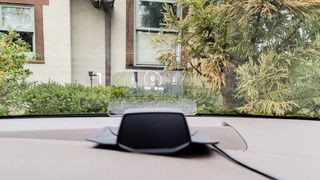A heads-up display (HUD) powered by your car’s OBD2 port can revolutionize your driving experience. By projecting crucial vehicle information directly onto your windshield, a Hud Obd2 Display keeps your eyes on the road while providing real-time data like speed, RPM, fuel economy, and more. This allows for safer and more informed driving, minimizing distractions and enhancing your awareness of your vehicle’s performance.
Understanding HUD OBD2 Displays: A Comprehensive Guide
HUDs have evolved significantly from luxury car features to affordable and accessible accessories for any vehicle with an OBD2 port. These displays utilize the diagnostic data from your car’s computer to present key information in a clear and concise format, right within your line of sight.
Types of HUD OBD2 Displays
- Basic OBD2 HUDs: These displays focus on essential information like speed, RPM, and engine temperature. They are generally more affordable and easy to install.
- Advanced OBD2 HUDs: These offer a wider range of data, including fuel economy, coolant temperature, battery voltage, and even diagnostic trouble codes (DTCs). Some models feature GPS integration for navigation and speed limit alerts.
- Smartphone Integrated HUDs: These connect to your smartphone via Bluetooth to display navigation instructions, incoming calls, and text messages. While convenient, they can introduce more potential distractions.
Hudway Drive, an advanced HUD OBD2 display with a built-in screen.
Key Features to Consider
- Display Size and Brightness: Ensure the projected image is large and bright enough to be easily visible in various lighting conditions, without obstructing your view.
- Data Parameters: Consider which data points are most important to you. Basic models typically display speed and RPM, while advanced options provide a broader range of information.
- OBD2 Compatibility: Confirm that the HUD is compatible with your vehicle’s OBD2 port and protocols. Most modern cars (post-1996) are equipped with OBD2.
- Ease of Installation and Use: Look for a HUD with a simple installation process and an intuitive user interface.
- Power Source: Most HUDs draw power directly from the OBD2 port, eliminating the need for additional wiring.
Pyle PHUD180BD, a budget-friendly HUD with a large display.
Benefits of Using a HUD OBD2 Display
- Enhanced Safety: By keeping your eyes on the road, you reduce the risk of accidents caused by looking down at the dashboard.
- Improved Situational Awareness: Real-time data about your vehicle’s performance allows you to react quickly to potential issues.
- Reduced Driver Fatigue: Minimizing eye movement and head tilting can help reduce strain and fatigue on long drives.
- Performance Monitoring: Monitor vital engine parameters to optimize fuel efficiency and identify potential problems early on.
Wiiyii C1, a compact HUD with OBD2 and GPS functionality.
Choosing the Right HUD OBD2 Display
Selecting the best HUD for your needs depends on your driving style, budget, and desired features. Consider factors like display size, data parameters, and ease of use. Research different models and read reviews to find the perfect fit for your vehicle. A HUD OBD2 display is a valuable investment that can significantly enhance your driving experience, making it safer, more informative, and more enjoyable.
Akabane A500, a feature-rich HUD with performance testing capabilities.
Autool X95, a specialized HUD for off-roading.

